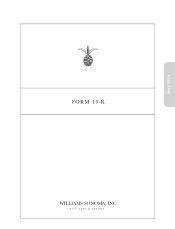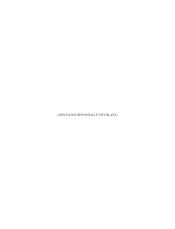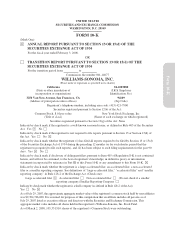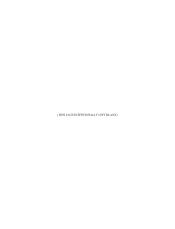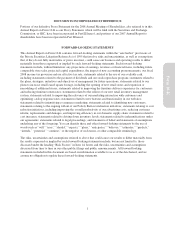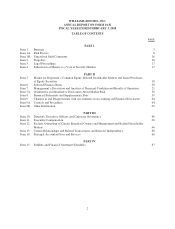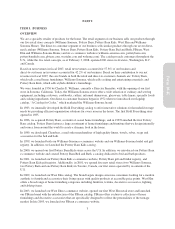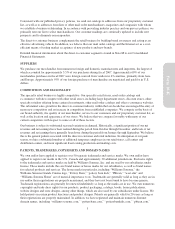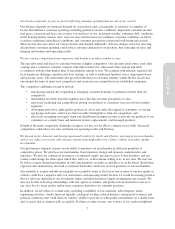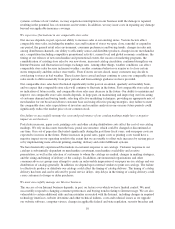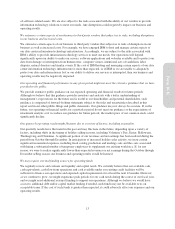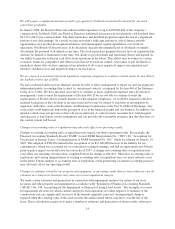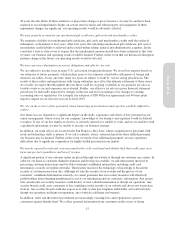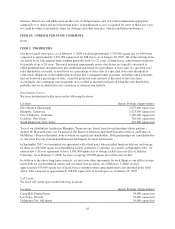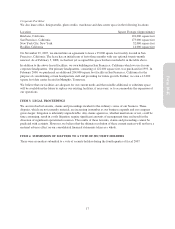Pottery Barn 2007 Annual Report Download - page 17
Download and view the complete annual report
Please find page 17 of the 2007 Pottery Barn annual report below. You can navigate through the pages in the report by either clicking on the pages listed below, or by using the keyword search tool below to find specific information within the annual report.
Our business depends, in part, on factors affecting consumer spending that are out of our control.
Our business depends on consumer demand for our products and, consequently, is sensitive to a number of
factors that influence consumer spending, including general economic conditions, disposable consumer income,
fuel prices, recession and fears of recession, war and fears of war, inclement weather, consumer debt, conditions
in the housing market, interest rates, sales tax rates and rate increases, inflation, consumer confidence in future
economic conditions and political conditions, and consumer perceptions of personal well-being and security.
These factors may also affect our various brands and channels differently. Adverse changes in factors affecting
discretionary consumer spending could reduce consumer demand for our products, thus reducing our sales and
harming our business and operating results.
We face intense competition from companies with brands or products similar to ours.
The specialty retail and direct-to-customer business is highly competitive. Our specialty retail stores, mail order
catalogs and e-commerce websites compete with other retail stores, other mail order catalogs and other
e-commerce websites that market lines of merchandise similar to ours. We compete with national, regional and
local businesses utilizing a similar retail store strategy, as well as traditional furniture stores, department stores
and specialty stores. The substantial sales growth in the direct-to-customer industry within the last decade has
encouraged the entry of many new competitors and an increase in competition from established companies.
The competitive challenges facing us include:
• anticipating and quickly responding to changing consumer demands or preferences better than our
competitors;
• maintaining favorable brand recognition and achieving customer perception of value;
• effectively marketing and competitively pricing our products to consumers in several diverse market
segments;
• developing innovative, high-quality products in colors and styles that appeal to consumers of varying
age groups and tastes, and in ways that favorably distinguish us from our competitors; and
• effectively managing our supply chain and distribution strategies in order to provide our products to our
consumers on a timely basis and minimize returns, replacements, and damaged products.
In light of the many competitive challenges facing us, we may not be able to compete successfully. Increased
competition could reduce our sales and harm our operating results and business.
We depend on key domestic and foreign agents and vendors for timely and effective sourcing of our merchandise,
and we are subject to various risks and uncertainties that might affect our vendors’ ability to produce quality
merchandise.
Our performance depends, in part, on our ability to purchase our merchandise in sufficient quantities at
competitive prices. We purchase our merchandise from numerous foreign and domestic manufacturers and
importers. We have no contractual assurances of continued supply, pricing or access to new products, and any
vendor could change the terms upon which they sell to us, or discontinue selling to us, at any time. We may not
be able to acquire desired merchandise in sufficient quantities on terms acceptable to us in the future. Better than
expected sales demand may also lead to customer backorders and lower in-stock positions of our merchandise.
Any inability to acquire suitable merchandise on acceptable terms or the loss of one or more of our key agents or
vendors could have a negative effect on our business and operating results because we would be missing products
that we felt were important to our assortment, unless and until alternative supply arrangements are secured. We
may not be able to develop relationships with new agents or vendors, and products from alternative sources, if
any, may be of a lesser quality and/or more expensive than those we currently purchase.
In addition, we are subject to certain risks, including availability of raw materials, labor disputes, union
organizing activities, vendor financial liquidity, inclement weather, natural disasters, and general economic and
political conditions, that could limit our vendors’ ability to provide us with quality merchandise on a timely basis
and at a price that is commercially acceptable. For these or other reasons, one or more of our vendors might not
7
Form 10-K


